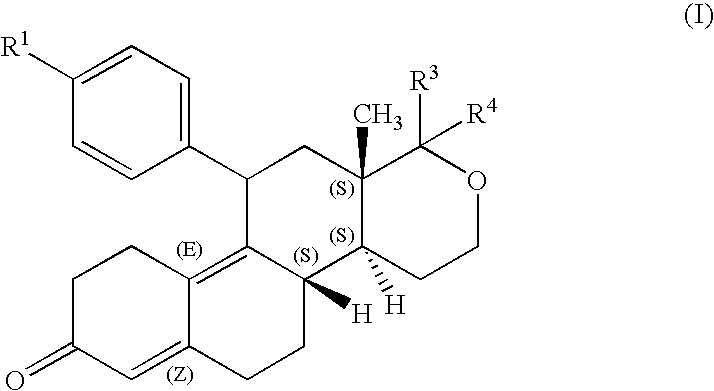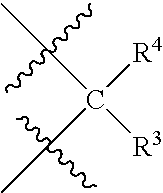Steroids derivatives as selective progesterone receptor modulators
a progesterone receptor and selective technology, applied in the field of steroid derivatives, can solve problems such as varied side effects, and achieve the effect of elevating blood glucose levels
- Summary
- Abstract
- Description
- Claims
- Application Information
AI Technical Summary
Benefits of technology
Problems solved by technology
Method used
Image
Examples
example 1
[0120]
[0121]Under argon, to a clear solution of the compound of formula (EX1)
[0122]
[0123](1.57 g, 5.0 mmol) in dry THF (15 mL) was added LDA (2.0 M THF solution, 1.1 equiv, 5.5 mmol, 2.8 mL) dropwise at −78° C. via syringe (dry ice / acetone bath). After the addition was completed, the reaction mixture was stirred for 1 hr at −78° C., followed by the addition of TMSCl (redistilled, 1.5 equiv, 5.5 mmol, 0.81 g). The reaction mixture was stirred for another 1 hr at −78° C., then warmed up to room temperature over 1 hr. The reaction mixture was quenched with saturated NaHCO3 at room temperature, then extracted with ethyl acetate (25 mL, 3 times). The combined the organic solvent was dried over anhydrous MgSO4, filtered and concentrated in vacuo and purified by column chromatography on silica gel to yield the title compound as a colorless liquid.
[0124]1H NMR (400 MHz, CDCl3): δ 5.39-5.33 (1H, m), 4.32-4.28 (1H, m), 3.78 (4H, s), 2.39-2.28 (1H, m), 2.06-1.83 (5H, m), 1.83-1.68 (2H, m), 1.6...
example 2
[0126]
[0127]Under argon, a suspension of the compound prepared as in Example 1 above (13.0 mmol, 5.20 g), NaHCO3 (130.0 mmol, 10.90 g) in hexane (300 mL) was added m-CPBA (13.0 mmol, 3.00 g) in portions. The crude reaction mixture was filtered through Celite®, then concentrated in vacuo to yield the crude product as a white foam. The crude material was purified by column chromatograph on silica gel (Rf 0.4, 1:1 ethyl acetate / Hexane). The fractions below starting material were collected and dissolved in hexane (300 mL). To the resulting mixture was then added K2CO3 (10.0 g) in one portion. The resulting mixture was stirred 2 hrs at room temperature. The title compound was isolated as a residue following column chromatograph.
[0128]1H NMR (400 MHz, CDCl3): δ 5.59-5.53 (1H, m), 4.43-4.38 (1H, m), 3.97 (4H, s), 2.58-2.48 (1H, m), 2.39-2.33 (1H, m), 2.32-2.28 (1H, m), 2.28-2.08 (4H, m), 2.08-1.99 (3H, m), 1.98-1.86 (1H, m), 1.84-1.74 (3H, m), 1.55 (1H, brs), 1.38-1.22 (1H, m), 0.97 (3H, s...
example 3
[0130]
[0131]To the solution of the compound prepared as in Example 2 above, (4.8 mmol, 1.58 g) in 1:1 mixture of methanol (40 mL) and benzene (40 mL) at 0° C. was added Pb(OAc)4 (7.5 mmol, 3.34 g) in one portion. The resulting mixture was stirred for 30 mins and monitored by TLC until the disappearance of starting material. After the reaction was determined to be completed, Celite® was added to the reaction mixture, which was then further diluted with 20% solution of ethyl acetate and hexane. The resulting mixture was filtered though a thin layer of silica gel. The filtrate was concentrated in vacuo and purified by column chromatograph to yield the title compound as a residue.
[0132]1H NMR (400 MHz, CDCl3): δ 9.71 (1H, t, J=2.0 Hz), 5.59-5.54 (1H, m), 3.99 (4H, s), 3.65 (3H, s), 2.69-2.62 (1H, m), 2.58-2.41 (2H, m), 2.36-2.31 (2H, m), 2.29-2.25 (2H, m), 2.24-2.08 (3H, m), 2.02-1.94 (1H, m), 1.90-1.75 (4H, m), 1.35-1.23 (1H, m), 1.11 (3H, s). MS (361, M++H).
PUM
| Property | Measurement | Unit |
|---|---|---|
| enantiomeric excess | aaaaa | aaaaa |
| enantiomeric excess | aaaaa | aaaaa |
| enantiomeric excess | aaaaa | aaaaa |
Abstract
Description
Claims
Application Information
 Login to View More
Login to View More - R&D
- Intellectual Property
- Life Sciences
- Materials
- Tech Scout
- Unparalleled Data Quality
- Higher Quality Content
- 60% Fewer Hallucinations
Browse by: Latest US Patents, China's latest patents, Technical Efficacy Thesaurus, Application Domain, Technology Topic, Popular Technical Reports.
© 2025 PatSnap. All rights reserved.Legal|Privacy policy|Modern Slavery Act Transparency Statement|Sitemap|About US| Contact US: help@patsnap.com



